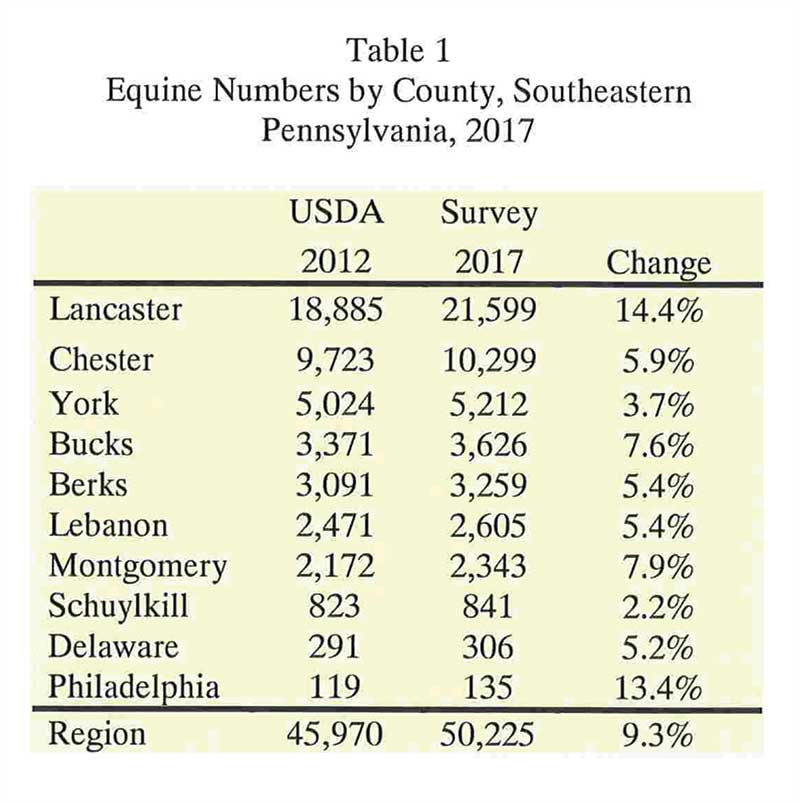 Credit Delaware Valley University
Credit Delaware Valley University
The equine industry is alive and well and thriving in southeastern Pennsylvania, a new study by Delaware Valley University shows.
The Impact of the Equine Industry on the Economy of Southeastern Pennsylvania studied the horse industry in Berks, Bucks, Chester, Delaware, Lancaster, Lebanon Montgomery, Philadelphia, Schuylkill and York Counties, an area which the US Department of Agriculture 2012 Census says accounts for 36 percent of the equine population of Pennsylvania and 32 percent of the equine farms. The survey determined that there are more than 50,000 equines in the 10-county region, an increase of 9.3 percent over the past five years.
The equine industry spends $546 million on goods, services, wages, and salaries in Southeastern Pennsylvania. Horse owners and enthusiasts in this region spend $386 million on equine-related goods and services each year. The industry employs 6,550 people with an annual payroll of $160 million. When indirect spending is included, the economic impact of the equine industry in the 10-county region is $670 million per year. Equine activities generate $58 million in tax revenue, including $8.8 million in property taxes.
The top three numbers of equines were found in Lancaster County, with 21,599, up 14.4 percent from 18,885 in 2012; Chester with 10,299, up 5.9 percent from 9,723 in 2012; and York, with 5,024 equines, up 3.7 percent from 5,024 in 2012. The 10-county region was home to 50,225 equines, up 9.3 percent from 45,970 in 2012.
The largest expenditure categories were feed, $72.4 million; purchases of horses, donkeys and mules, $55.8 million; boarding $33.3 million per year; and capital improvements such as barns or arenas, $24 million per year.
Thoroughbreds were the most populous breed, with more than 3,000 thoroughbreds in the region, followed by warmbloods and quarter horses. Pleasure was the most popular activity, followed by hunter/jumper and dressage.
The equine industry plays a vital role in maintaining open spaces and agricultural production.
Nearly 70,000 acres in the region were devoted to equine use, most of which is in pasture. That represents about five percent of agricultural land in the region. Lancaster and Chester Counties account for more than two-thirds of the acreage devoted to equines in the region.
The study was commissioned by the Chester-Delaware County Farm Bureau and funded in large part by a grant from the Pennsylvania Department of Education under the Jobs Training and Educational Programs. The last study of the equine industry in Pennsylvania was conducted by Penn State University and published in 2003. It covered the entire state of Pennsylvania.
John Urbanchuk, chair of agribusiness at DelVal, directed the study. Dr. Sarah Young, chair of the DelVal animal science department; Cory Kieschnick, chair of the DelVal equine science and management department; and Christine Seel; co-chair of the DelVal business and information management department worked with Urbanchuk on the study.
The study was released at a panel discussion at New Bolton Center in Chester County. In attendance were state Senator Andrew Dinniman, six time Olympian Phillip Dutton, Agriculture Secretary Russell Redding, Susan Hamley, Chester County Conference and Visitors Bureau, Carl “Bunny” Meister, Realtor with James A. Cochrane Inc., and Brian Sanfratello, Executive Secretary of the Pennsylvania Horse Breeders Association.
Dutton, who came to Chester County 25 years ago, said the region has established itself as the place to be for horse sporting and that reputation continues to grow.
“I came to this area and got immersed with some of the best people that service the horse industry. Looking back after six Olympics, I’m proud to say that I’ve been here and it’s helped me immensely to be here,” he said. “The Napa Valley is known for wine. Nashville is known for country music. Detroit for cars. Well, Chester County is known for the horse industry and for sport horses.”
“One of our key selling points is the scenic beauty of our rolling hills and preserved land,” Hamley said. “Almost 30 percent of the county is permanently preserved land.”




